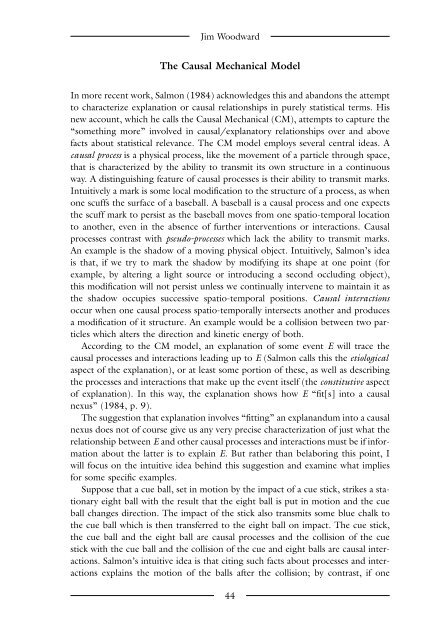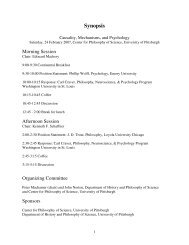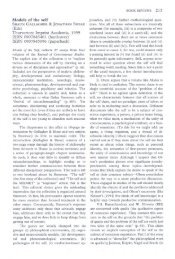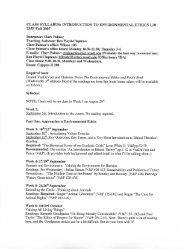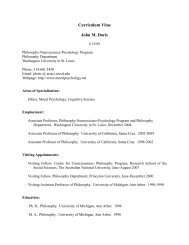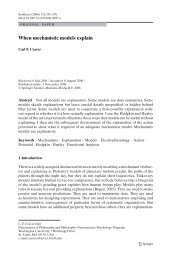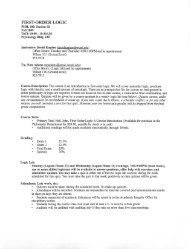The Blackwell Guide to the Philosophy of Science - The Department ...
The Blackwell Guide to the Philosophy of Science - The Department ...
The Blackwell Guide to the Philosophy of Science - The Department ...
You also want an ePaper? Increase the reach of your titles
YUMPU automatically turns print PDFs into web optimized ePapers that Google loves.
Jim Woodward<br />
<strong>The</strong> Causal Mechanical Model<br />
In more recent work, Salmon (1984) acknowledges this and abandons <strong>the</strong> attempt<br />
<strong>to</strong> characterize explanation or causal relationships in purely statistical terms. His<br />
new account, which he calls <strong>the</strong> Causal Mechanical (CM), attempts <strong>to</strong> capture <strong>the</strong><br />
“something more” involved in causal/explana<strong>to</strong>ry relationships over and above<br />
facts about statistical relevance. <strong>The</strong> CM model employs several central ideas. A<br />
causal process is a physical process, like <strong>the</strong> movement <strong>of</strong> a particle through space,<br />
that is characterized by <strong>the</strong> ability <strong>to</strong> transmit its own structure in a continuous<br />
way. A distinguishing feature <strong>of</strong> causal processes is <strong>the</strong>ir ability <strong>to</strong> transmit marks.<br />
Intuitively a mark is some local modification <strong>to</strong> <strong>the</strong> structure <strong>of</strong> a process, as when<br />
one scuffs <strong>the</strong> surface <strong>of</strong> a baseball. A baseball is a causal process and one expects<br />
<strong>the</strong> scuff mark <strong>to</strong> persist as <strong>the</strong> baseball moves from one spatio-temporal location<br />
<strong>to</strong> ano<strong>the</strong>r, even in <strong>the</strong> absence <strong>of</strong> fur<strong>the</strong>r interventions or interactions. Causal<br />
processes contrast with pseudo-processes which lack <strong>the</strong> ability <strong>to</strong> transmit marks.<br />
An example is <strong>the</strong> shadow <strong>of</strong> a moving physical object. Intuitively, Salmon’s idea<br />
is that, if we try <strong>to</strong> mark <strong>the</strong> shadow by modifying its shape at one point (for<br />
example, by altering a light source or introducing a second occluding object),<br />
this modification will not persist unless we continually intervene <strong>to</strong> maintain it as<br />
<strong>the</strong> shadow occupies successive spatio-temporal positions. Causal interactions<br />
occur when one causal process spatio-temporally intersects ano<strong>the</strong>r and produces<br />
a modification <strong>of</strong> it structure. An example would be a collision between two particles<br />
which alters <strong>the</strong> direction and kinetic energy <strong>of</strong> both.<br />
According <strong>to</strong> <strong>the</strong> CM model, an explanation <strong>of</strong> some event E will trace <strong>the</strong><br />
causal processes and interactions leading up <strong>to</strong> E (Salmon calls this <strong>the</strong> etiological<br />
aspect <strong>of</strong> <strong>the</strong> explanation), or at least some portion <strong>of</strong> <strong>the</strong>se, as well as describing<br />
<strong>the</strong> processes and interactions that make up <strong>the</strong> event itself (<strong>the</strong> constitutive aspect<br />
<strong>of</strong> explanation). In this way, <strong>the</strong> explanation shows how E “fit[s] in<strong>to</strong> a causal<br />
nexus” (1984, p. 9).<br />
<strong>The</strong> suggestion that explanation involves “fitting” an explanandum in<strong>to</strong> a causal<br />
nexus does not <strong>of</strong> course give us any very precise characterization <strong>of</strong> just what <strong>the</strong><br />
relationship between E and o<strong>the</strong>r causal processes and interactions must be if information<br />
about <strong>the</strong> latter is <strong>to</strong> explain E. But ra<strong>the</strong>r than belaboring this point, I<br />
will focus on <strong>the</strong> intuitive idea behind this suggestion and examine what implies<br />
for some specific examples.<br />
Suppose that a cue ball, set in motion by <strong>the</strong> impact <strong>of</strong> a cue stick, strikes a stationary<br />
eight ball with <strong>the</strong> result that <strong>the</strong> eight ball is put in motion and <strong>the</strong> cue<br />
ball changes direction. <strong>The</strong> impact <strong>of</strong> <strong>the</strong> stick also transmits some blue chalk <strong>to</strong><br />
<strong>the</strong> cue ball which is <strong>the</strong>n transferred <strong>to</strong> <strong>the</strong> eight ball on impact. <strong>The</strong> cue stick,<br />
<strong>the</strong> cue ball and <strong>the</strong> eight ball are causal processes and <strong>the</strong> collision <strong>of</strong> <strong>the</strong> cue<br />
stick with <strong>the</strong> cue ball and <strong>the</strong> collision <strong>of</strong> <strong>the</strong> cue and eight balls are causal interactions.<br />
Salmon’s intuitive idea is that citing such facts about processes and interactions<br />
explains <strong>the</strong> motion <strong>of</strong> <strong>the</strong> balls after <strong>the</strong> collision; by contrast, if one<br />
44


